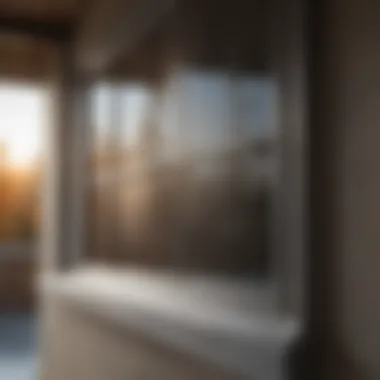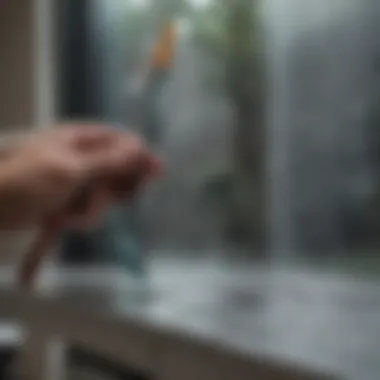The Ultimate Guide to Washing Windows with a Squeegee


Intro
Cleaning windows can often be a daunting task, but knowing the right technique can transform it into a manageable chore. The use of a squeegee is one of the most effective methods for achieving a clear, streak-free finish. This process is not simply about getting rid of dirt; it involves understanding the tools, solutions, and techniques that will optimize your efforts and results.
In this article, we will explore the best practices for washing windows using a squeegee. We will uncover the essential tools you need, the best cleaning solutions, and tips on executing each step efficiently. By the end, you will have a comprehensive understanding of how to maintain windows to enhance the clarity of your living spaces.
Home Features
Importance of Clean Windows
Clean windows not only contribute to the aesthetic appeal of your home but also increase the longevity of the window materials. Regular maintenance helps prevent the accumulation of grime and dirt that can deteriorate window frames and glass over time.
Tools Needed for Effective Window Washing
To achieve the best results, certain tools are essential:
- Squeegee: A quality squeegee is vital. Look for one with a rubber blade in good condition to avoid streaks.
- Buckt: A stable bucket will help contain your cleaning solution and allow for easy access.
- Scrubber or Sponge: A soft cloth or scrubber can help break down dirt on the glass surface.
- Cleaning Solution: A pH-balanced window cleaner or a homemade solution using vinegar and water works effectively.
- Lint-free Cloth: For final touch-ups, a microfiber cloth can eliminate any lingering streaks.
Techniques for Washing Windows with a Squeegee
Step-by-Step Process
- Prepare the Area: Clear the surrounding area to avoid damaging anything with water or cleaning solution.
- Mix Your Solution: Use the recommended cleaning solution in a bucket, ensuring it is well mixed.
- Apply the Solution: Dip the scrubber or sponge into the solution and apply it evenly on the glass. Make sure to cover all corners and edges.
- Use the Squeegee: Begin at the top left and pull downwards in a straight line. After each swipe, wipe the squeegee blade with a cloth to prevent streaking.
- Dry the Edges: Use a lint-free cloth to wipe any remaining water from the edges.
"Following a systematic approach ensures that every inch of glass receives the necessary attention, resulting in impeccable transparency."
Expert Tips for Optimal Results
- Perform window cleaning on overcast days; direct sunlight can cause the solution to dry too quickly, leaving streaks.
- Change your cleaning solution frequently to maintain its effectiveness.
- For very dirty windows, consider repeating the process if needed for optimal clarity.
By understanding the significance of clean windows and employing the right tools and techniques, homeowners can greatly enhance their living spaces. A clear view can transform not just the room but the entire home. In the following sections, we will delve deeper into the science behind window cleaning and explore how to sustain the beauty and efficiency of your windows long term.
Understanding Window Cleaning
Window cleaning may seem like a mundane task, yet it holds significant importance in maintaining both the aesthetics and functionality of a home or building. Clean windows enhance the visual appeal of a property and allow natural light to flood in. They also contribute to the overall atmosphere, making spaces feel brighter and more inviting.
Furthermore, windows can accumulate dirt, grime, and pollutants over time. This build-up not only obstructs views but may also lead to more significant issues in the future, particularly regarding window materials and seals. Keeping windows clean prevents deterioration and extends their lifespan. Thus, understanding how to clean windows properly becomes paramount for any homeowner.
Many homeowners overlook the nuances of cleaning their windows, thinking that any method will suffice. However, the process involves specific techniques and tools to achieve the best results. Additionally, a well-maintained window can improve energy efficiency by allowing optimal sunlight, which aids in heating spaces naturally. Therefore, dedicating time to regular window cleaning will result in both aesthetic and functional benefits.
Importance of Clean Windows
The significance of clean windows extends beyond appearance. Here are some reasons why maintaining cleanliness is essential:
- Enhances Curb Appeal: Gleaming windows create a positive first impression for visitors and potential buyers. They reflect care and attention to detail in property upkeep.
- Increases Natural Light: Windows that shine allow more light to penetrate, brightening interiors and reducing the need for artificial lighting.
- Improves Air Quality: Dust and allergens can settle on window surfaces, impacting indoor air quality. Regular cleaning helps reduce these particles, promoting healthier living conditions.
Moreover, clean windows contribute to overall building maintenance. They prevent issues like mold and deterioration in frames and seals. In the long run, investing time in window upkeep can save costly repairs and replacements.
Common Window Cleaning Myths


There are several misconceptions surrounding window cleaning that can lead to ineffective practices. Here are a few myths debunked:
- Myth 1: Rain will clean the windows: Some believe that rain takes care of window cleanliness. However, rain can deposit minerals and dirt, leading to streaky and dirty windows.
- Myth 2: All cleaning products are the same: Many think they can use any home cleaner without consequences. However, some products can leave residue or streaks. Specific window cleaning solutions foster better results.
- Myth 3: Newspaper is the best tool: While some swear by using newspaper for drying, modern cleaning tools, like microfiber cloths, are often more effective and do not leave behind ink or fibers.
It is essential to separate fact from fiction. Understanding the facts about window cleaning can make a significant difference in efficiency and effectiveness. Learning the right methods to use will ultimately bring forth the best results and ensure that windows are not just clean but properly maintained.
Tools Needed for Window Washing
Understanding the tools required for window washing is essential for achieving optimal results. The right equipment not only facilitates the cleaning process but also ensures that you can produce streak-free and spotless windows. Window washing can often feel like a daunting task; however, with the right tools, the effort can be significantly minimized. Each tool serves a specific purpose and contributes to enhancing efficiency and effectiveness in cleaning. In the subsequent sections, you will discover how to choose the right squeegee and the complementary equipment that makes a substantial difference in window cleaning.
Choosing the Right Squeegee
Selecting a squeegee might seem trivial, but it is one of the most crucial decisions in achieving clear and streak-free windows. A good squeegee must have a flexible rubber blade that hugs the glass surface, preventing water from being left behind. The handle should be comfortable and provide a good grip, as you'll be using it multiple times during the cleaning process.
The size of the squeegee also matters depending on the window size you will be working with. For larger windows, a wider squeegee is effective, while a smaller, compact squeegee might be best for detail work or smaller windows. Investing in a high-quality squeegee pays off in the long run, as it can reduce the frequency of cleaning and make your windows shine brighter.
Additional Cleaning Equipment
Having additional cleaning equipment is essential to complement your squeegee. This equipment enhances the wash and simplifies the overall process. Here’s a closer look at some of the tools that can elevate your window washing experience.
Buckets
Buckets are fundamental in the window washing process. They are used to store the cleaning solution and provide a convenient way to dip your mop or applicator. A bucket with a spout can help pour the solution more easily. The size should be manageable yet big enough to hold ample cleaning solution.
A translucent bucket can be beneficial as it allows you to see the level of cleaning solution quickly. Moreover, some buckets come with a wringer feature, which is useful for controlling the amount of liquid on your applicator, ensuring that you do not oversaturate your cleaning tools.
Mop or Applicator
A mop or applicator is critical for applying the cleaning solution evenly across the glass surface. The main characteristic of a good applicator is its absorbency and coverage area. It should work effectively in lifting dirt while distributing the cleaning solution uniformly, ensuring that all spots are addressed.
One of the unique features of certain applicators is the scrubber, which can tackle tougher grime and dirt buildup. Using an applicator allows for deeper cleaning, resulting in a polished look without streaks left behind by dirt and dust.
Ladders and Safety Gear
Using ladders safely is an often-overlooked aspect of window washing, especially for higher windows. A sturdy ladder that can support your weight is non-negotiable. The main characteristic to look for is stability so that you can work confidently. Ensure that the ladder is positioned on stable ground and that you maintain three points of contact while on it.
Safety gear must not be deemed optional, especially when you are working at heights. Wearing non-slip shoes, a helmet, and gloves can protect you from accidental falls and injuries. Additionally, having someone assist you when working on ladders can enhance safety and mitigate risks associated with window washing.
Effective Window Washing Solutions
The choice of window cleaning solution significantly impacts the overall cleaning effectiveness. Selecting the right type of cleaner can lead to clearer, streak-free results, while using unsuitable products might result in unsatisfactory outcomes. This section delves into two main options: commercial cleaners and homemade solutions. Both have their unique benefits, and understanding these can help homeowners make informed decisions.
Commercial vs. Homemade Cleaners
Commercial window cleaners are specially formulated products designed to tackle tough grime, dirt, and stains. They often contain specific surfactants that break down dirt without leaving residue. Popular brands include Windex and Sprayway. These solutions are easy to use and generally require minimal mixing or preparation.
However, homemade cleaners can also be highly effective. Common ingredients such as distilled vinegar and dish soap can combine to form an excellent cleaning solution. The following are some benefits of each type:
- Commercial Cleaners
- Homemade Cleaners
- Ready to use with no preparation needed.
- Formulated for various types of glass and environments.
- Often provide additional features, like anti-fogging agents.


- Environmentally friendly, with no harsh chemicals.
- Cost-effective, using ingredients most households already have.
- Customizable based on personal preferences or cleaning needs.
For homeowners looking to minimize chemical exposure, homemade options may present a safer choice. Still, it is crucial to test any homemade solutions on a small area before applying broadly.
Water Quality Considerations
Water quality plays a critical role in successful window cleaning. Hard water contains minerals such as calcium and magnesium that can leave behind spots and streaks. Using hard water for cleaning can diminish the effects of both commercial and homemade cleaners. Here are some considerations regarding water quality:
- Using Distilled Water
Distilled water is stripped of its minerals, making it ideal for cleaning purposes. It can help prevent spots from forming on the glass surface. - Filter Systems
Installing a home water filter can reduce hard water minerals. This investment may not only benefit window cleaning but also improve the overall quality of water used in daily tasks. - Checking Local Water Sources
Understanding the quality of local water supplies can guide choices in cleaning solutions and methods. If hard water is a concern, it may influence the effectiveness of both types of cleaners.
Using the right cleaning solution alongside high-quality water is crucial for achieving the best possible results. The impact of these choices illustrates how small adjustments can lead to significantly improved window appearance.
Preparing for Window Cleaning
Before leap into the practical steps of washing windows, it is vital to prepare properly. The preparation phase is integral to ensure that the cleaning process is effective and safe. Adequate preparation not only leads to better results but also minimizes the risk of accidents or damage.
Assessing the Condition of Windows
Assessing the condition of windows should be the first step in your preparation. This involves inspecting the glass surface for any damage, such as cracks or chips. Windows in poor condition may need repairs prior to cleaning. Any dirt or debris left on damaged windows during cleaning can worsen the damage and lead to further complications.
Additionally, it is key to identify the type of grime on the windows. Are they dirty due to dust, bird droppings, or something else? Different types of dirt may require varying cleaning solutions. For instance, sticky residues may need more aggressive cleaning agents, while dust can often be addressed with simple soap and water.
Furthermore, considering the window frames and sills is important. These areas can accumulate dirt and dust over time, and failing to clean them may lead to ongoing buildup that could affect your windows and home aesthetics in the long run.
Safety Precautions
Safety precautions cannot be ignored while preparing for window cleaning. Ensuring a safe working environment reduces the risk of accidents. First, gather necessary safety gear. Using rubber gloves protects your hands from harsh chemicals. If you are working at heights, investing in a good quality ladder is imperative.
Stabilizing the ladder is also crucial. Always place the ladder on a flat surface and never reach too far to the side. This can cause it to tip over. If possible, have someone support the ladder while you are working.
When using any cleaning solutions or chemicals, read labels carefully. Many commercial products can be harmful if not handled correctly. Using proper ventilation is also essential, especially when working indoors. Open windows to increase airflow and wear a mask if necessary to avoid inhaling fumes.
In summary, taking the time to assess the condition of your windows and following necessary safety precautions will prepare you for an effective and risk-free window cleaning experience. Such preparation ensures that every window shines bright and clear.
Step-by-Step Window Cleaning Process
The step-by-step window cleaning process is vital for ensuring that windows are not only clean but also free from streaks and smudges. This process provides a structured approach, allowing homeowners and design enthusiasts to maximize efficiency while achieving the desired aesthetic result. Following these steps also helps in preventing damage to windows and surrounding surfaces. Each phase addresses specific elements that contribute to superior cleanliness and visual clarity.
Applying the Cleaning Solution
Applying the cleaning solution correctly is essential to preparing the window surface for cleaning. First, choose an appropriate cleaning solution based on the type of dirt or grime present. A simple mixture of water and a few drops of dish soap can often suffice for routine cleaning. For tougher stains, consider using commercial window cleaners or a vinegar-water solution.
Before application, ensure that the solution is mixed thoroughly. Use a large mop or applicator to evenly apply the solution to the window. Start at the top and work your way down to prevent drips from contaminating clean areas. Ensure you cover all corners and edges where dirt tends to accumulate.
"Applying too much solution can lead to a mess, so moderate the amount you use as you clean."
Squeegee Technique for Streak-Free Results
The technique employed when using a squeegee can significantly influence the outcome. Hold the squeegee at a 45-degree angle and start at the top of the window. Pull the squeegee down in a straight line, applying even pressure. It's important to wipe the blade with a clean cloth after each pass to avoid redistributing dirt.
Using horizontal or vertical strokes can depend on personal preference but maintaining consistency throughout the process will yield better results. If you notice streaks, you may need to adjust your technique or revisit the cleaning solution application.


Final Touches and Drying
Once you have gone over the window with the squeegee, some final touches can enhance the streak-free finish. Use a microfiber cloth to wipe the edges and corners where the squeegee may not reach. Pay attention to any areas that may still appear wet or smeared.
For drying, allow the window air to dry completely under normal conditions. Avoid direct sunlight if possible, as this can lead to quick evaporation and water spots. If a more polished look is desired, consider using a clean towel to buff the surface lightly after the initial drying has taken place. This ensures a crystal-clear, smooth appearance, elevating the overall look of your windows.
Maintaining Window Cleanliness
Maintaining window cleanliness is an essential aspect of home maintenance. Clean windows significantly enhance curb appeal and allow for better natural light in interiors. It also prevents the degradation of window materials by eliminating corrosive substances found in dirt, dust, and mineral deposits. Regular maintenance prolongs the lifespan of your windows and keeps view unobstructed.
Frequency of Cleaning
The frequency of cleaning windows depends on several factors including environmental elements and personal preference. In urban areas, windows may accumulate grime more quickly due to pollutants. Consequently, a good practice is to perform a thorough cleaning at least every six months. On the other hand, windows in rural environments might require less frequent attention, perhaps every year.
Weather conditions also affect cleaning schedules. During pollen season or windy months, windows may need to be cleaned more often. A regular maintenance routine can help you remain on top of dirt buildup. Keeping a calendar with specific dates marked for window cleaning can help ensure consistency and efficiency.
Tips for Long-Lasting Clean Windows
To keep windows looking their best for longer, here are some effective tips:
- Use High-Quality Cleaners: Choose effective cleaning solutions that are specifically designed for window glass. Many commercial brands are reliable and can make a noticeable difference.
- Application Technique Matters: When applying the cleaning solution, use a microfiber cloth or mop to cover more surface area without streaking. This reduces residue buildup.
- Optimal Weather Conditions: Clean windows on cool, cloudy days to prevent cleaning solutions from drying too fast, leading to streaks.
- Regular Maintenance Check-ups: Inspect windows regularly for signs of wear or damage. Addressing small issues promptly can help maintain overall window cleanliness and longevity.
"Regular window cleaning not only enhances aesthetics but also plays an important role in window maintenance."
By following these guidelines, you can ensure your windows remain clear and beautiful, contributing to a pleasant living environment.
Troubleshooting Common Issues
Understanding how to troubleshoot common issues when washing windows is invaluable for achieving optimal results. It can make the difference between a clear view and a frustrating experience. This section discusses some typical problems homeowners may encounter, along with practical solutions.
Dealing with Streaks
Streaks are perhaps the most bothersome issue when it comes to window cleaning. They can ruin the appearance of an otherwise spotless window. These marks often arise from using an incorrect cleaning solution, excessive soap, or improper squeegee techniques. To minimize streaks, consider the following tips:
- Use the Right Solution: Check what you use for cleaning. Sometimes, household glass cleaners can leave residues behind. Instead, opt for a mixture of water and vinegar for a streak-free shine.
- Proper Squeegee Use: Ensure you start from the top. Apply even pressure and pull downward with a slight angle. Wipe the squeegee blade after each stroke to prevent the transfer of dirt and cleaner.
- Drying Techniques: If the conditions allow, wash your windows on overcast days. Sunlight can dry the windows too quickly, causing streaks. After cleaning, dry the edges with a lint-free cloth to remove remaining moisture.
"A clean window means not only a clearer view but also increased aesthetic appeal in your living space."
Removing Hard Water Deposits
Hard water deposits can also pose serious challenges. These deposits form due to mineral build-up and may make windows appear foggy or dirty. Removing these requires several steps:
- Identify the Deposits: First, check if you have hard water stains. They usually appear as white or cloudy spots on glass surfaces.
- Cleaning Solution: Use a solution of equal parts vinegar and water. Let it sit on the affected area for several minutes to allow it to penetrate the deposits.
- Scrubbing the Surface: Use a non-scratch scrub sponge to scrub the area gently. Avoid using abrasive materials as they can damage the glass.
- Final Rinse: After scrubbing, rinse the window thoroughly with clean water. Make sure to dry the surface with a soft cloth or squeegee to avoid streaks.
By efficiently addressing these issues, maintaining clean windows becomes a less daunting task. Practicing these techniques will undoubtedly enhance the overall appearance of your windows, serving both functional and aesthetic purposes.
End
In this article, the importance of proper window cleaning techniques is evident. Achieving a streak-free shine not only enhances the aesthetic appeal of your home but also contributes to the overall quality of your living space. Clean windows improve the flow of natural light, which positively influences mood and productivity.
Key considerations when it comes to window cleaning include the selection of appropriate tools, understanding effective cleaning solutions, and mastering the application techniques. Each element plays a significant role in achieving optimal results. A good squeegee, for instance, is essential for removing dirt and moisture without leaving streaks behind.
Regular maintenance is also crucial. Establish a cleaning schedule that suits your environment and lifestyle. Tips for long-lasting clean windows can significantly reduce the effort needed during cleaning sessions. Proactive strategies, such as using proper safety gear and understanding the condition of your windows, are essential for effective upkeep.
"A clear view not only beautifies your space but also reflects your commitment to home maintenance."
Through this guide, readers can appreciate the methods outlined and apply them, ensuring their windows are not only clean but also maintained in a way that promotes longevity. Window cleaning shouldn't feel like a daunting task. With the right knowledge, tools, and techniques, it becomes a manageable and even rewarding part of home care. In doing so, maintaining a clear and inviting view is not just a chore but a fulfilling practice.



